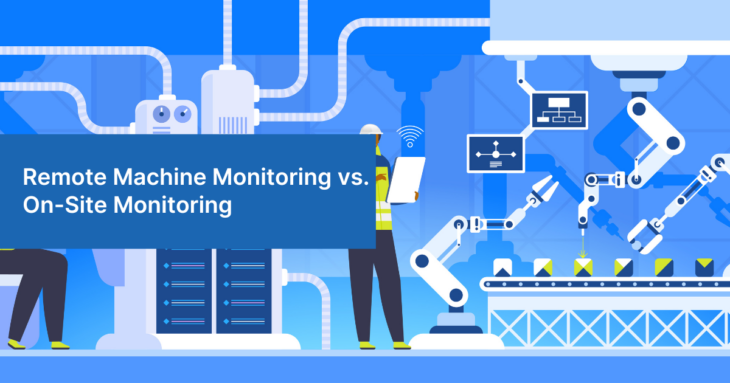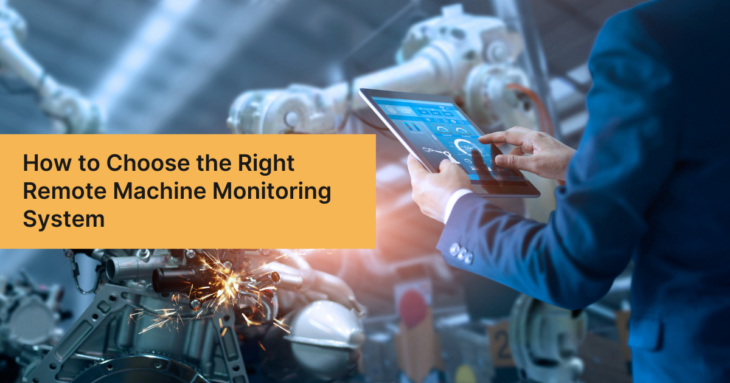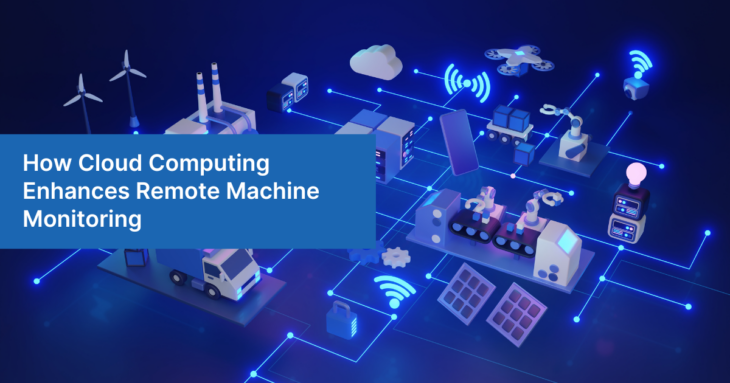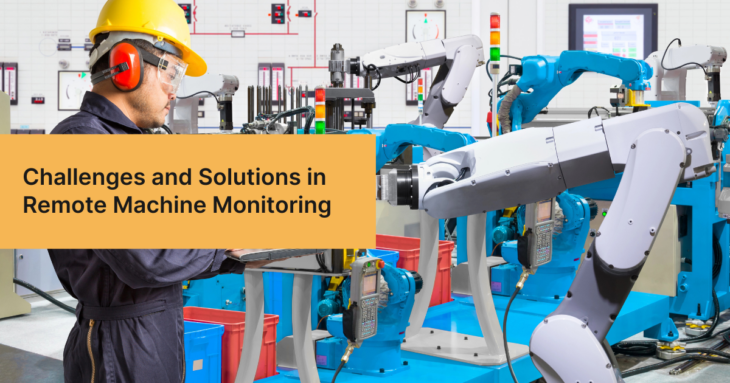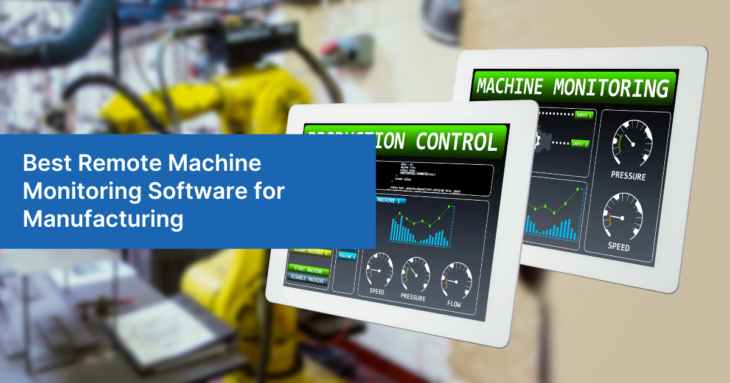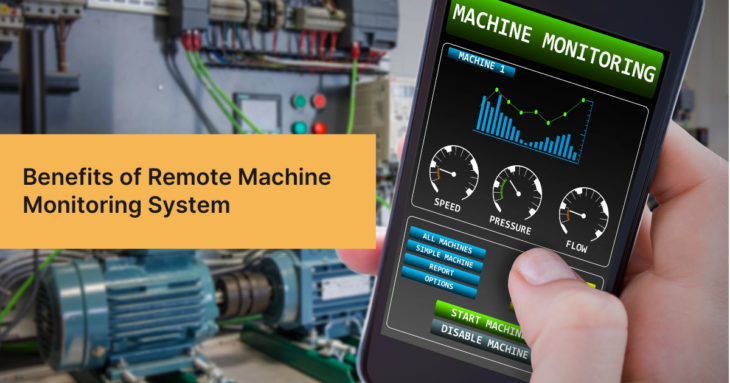Remote Machine Monitoring vs. On-Site Monitoring
Monitoring machinery in manufacturing is like having a pulse on the equipment. It tells you when the machines are running smoothly and helps catch issues before they spiral out of control. Traditionally, monitoring was done on-site with technicians physically present to check every detail. But as technology advances remote machine monitoring is becoming the next logical step as it offers real-time data and control from anywhere. In this article, we’ll take a closer look at remote machine monitoring vs. on-site monitoring and explore their benefits, challenges, and differences. On-Site Monitoring On-site monitoring is the traditional way of keeping an eye on machines in a manufacturing facility. It involves technicians and engineers being physically present to oversee operations. This manual approach allows them to monitor performance metrics, inspect components, and respond immediately to any issues. The technicians are always on-site watching machine parameters such as temperature, power consumption, spindle speed, tool wear, and other essential items specific to their process. One of the main advantages of on-site monitoring is the ability to access machine data instantly. Technicians on the ground can quickly spot and address abnormalities and minimize downtime. Because this method doesn’t rely on internet connectivity, it’s particularly useful in locations where network stability might be an issue. On-site monitoring requires a significant investment in human power and also needs skilled workers who are adept at monitoring machines and processes. Even in plants that employ some level of digitization to observe the process, on-site personnel are needed to monitor things. For companies with multiple manufacturing sites, scaling up on-site monitoring can also become costly. Remote Machine Monitoring Remote machine monitoring is made possible by using the Industrial Internet of Things (IIoT) and cloud-based platforms. With remote monitoring, manufacturers can collect real-time data from machines across multiple locations, analyze performance, and address issues without needing technicians on-site. One of the main benefits of remote monitoring is its scalability. Companies with multiple manufacturing sites can monitor all operations from a centralized dashboard and reduce the need for on-site staff. The data collected can be analyzed to identify patterns, predict maintenance needs, and prevent potential failures. In the long run, remote machine monitoring is useful for condition monitoring of machinery and equipment. Detailed performance data can be streamed and stored over time with sensors and IoT devices installed on machines. This data can be used to assess performance and predict loss in efficiency or equipment failure well in advance. While there are downsides to remote machine monitoring in the form of network and cybersecurity challenges, it is better in every parameter compared to on-site monitoring. Remote Machine Monitoring Vs. On-site Monitoring (H2) Now let’s look at some of the key remote machine monitoring vs. on-site monitoring differences: Difference Parameter Remote Machine Monitoring On-Site Monitoring Cost Savings Remote monitoring offers greater cost efficiency compared to on-site monitoring. On-site monitoring requires continuous investment in personnel, training equipment, and operations. It can add up in terms of cost especially in large or multi-site operations. Scalability Scalability with remote monitoring is a major benefit as it allows manufacturers to oversee multiple sites from a centralized location. The need for physical presence and skilled technicians limits on-site monitoring. Since an extensive training period is involved, scaling is slower compared to remote monitoring. Data Collection and Analytics Remote monitoring systems are designed to collect vast amounts of data in real-time. The data is instantly updated to secure servers and is available for analytics almost instantaneously. On-site monitoring can gather high-quality data. However, uploading manual data to the MES or ERP systems takes time, which makes instantaneous analytics impossible. Maintenance and Downtime Management By using predictive analytics, remote systems can identify potential issues before they lead to machine failure. Maintenance than then be scheduled appropriately. On-site monitoring is often reactive and addresses issues only after they’ve occurred. Security and Compliance Remote monitoring systems rely on internet networks making them vulnerable to cybersecurity threats. However, remote service providers have robust security features for data transfer and storage. On-site monitoring faces physical security risks, data breaches from human error, and sabotage. Compliance with industry standards also has to be part of mandatory training for the personnel. Decision Making Remote monitoring makes instantaneous, data-driven decisions a common thing with manufacturers. Collecting real-time data from machines provides a complete overview of operations that can be analyzed to identify trends and optimize performance. On-site monitoring also supports data-driven decision-making. However, there is a significant lag from when the data is collected to when it is uploaded to the system for analytics. The lack of real-time insight makes it hard to detect immediate trends and early warning signs. Competitive Advantage for Manufacturers With the world already in Industry 4.0, manufacturers adopting remote monitoring have a competitive edge over others. Moreover, they are able to offer better maintenance to clients backed by robust data. Although on-site monitoring is effective in smaller localized operations, it may not offer the same level of flexibility and scalability. Manufacturers relying solely on on-site monitoring might find it more challenging to compete globally. To Wrap It Up While both remote and on-site machine monitoring play their roles in manufacturing, the future is remote. We have seen the differences in remote machine monitoring vs. on-site monitoring in terms of cost, security and data-backed decision-making, and there’s a clear winner. Manufacturers need to incorporate remote machine monitoring to stay competitive in an ever-growing digital production ecosystem. If you wish to learn more about how you can upgrade to remote machine monitoring, get in touch with our team and request a demo!
Read MoreHow to Choose the Right Remote Machine Monitoring System?
If you’re assessing the feasibility of a machine monitoring system for your manufacturing unit, then you’re headed in the right direction. Remote monitoring is becoming a staple in manufacturing as the current shifts towards Industry 4.0. According to a McKinsey survey, digital upgrade of existing systems is now a top priority among machinery companies. The benefits it unlocks set them apart from the rest and open up business opportunities that were previously unavailable. So, how do you go about choosing the right remote machine monitoring system? In this article, we examine 8 key aspects and one case study on how it’s done right. Factors to Consider When Choosing a Remote Machine Monitoring System It’s a crucial decision requiring you to evaluate the following factors: 1. Assess the Monitoring Needs of Your Unit Start by pinpointing the specific metrics crucial for your operations that are ready for a digital transformation. Are you trying to track the resources through the plant or measure the temperature of a cast product through the conveyer system? It could be different things, from fluid temperature to hydraulic pressure in the pumps. Assess your existing setup and come up with gaps where the implementation of remote monitoring can be most useful. 2. Consider System Compatibility With Existing Equipment One of the most important aspects of choosing the right remote machine monitoring system is compatibility with your equipment. Even the most advanced solution in the market isn’t good enough if it doesn’t work with your equipment without major modifications. Compatibility reduces installation costs and avoids disrupting your operations. The monitoring solutions should support your equipment’s protocols and communication standards. Also, consider future upgrades and select a system adaptable to emerging systems so you’re not forced into costly replacements in the long run. 3. Look for Scalability With Your Business Your business is bound to grow and expand, and hence, any remote monitoring system you choose should be able to scale without offering resistance. Modular designs are particularly beneficial as they let you add new features or devices without reconfiguring the entire system. The same goes for upgrades, as any new IoT device you introduce should fit perfectly with the system. Consider how the system handles increased data volumes and additional sensors. The monitoring system should also be able to offer services customizable to any unique needs that you have. 4. Evaluate Data Security Features Data security is critical as the system exchanges information from devices to the monitoring platform. The system should have robust encryption to protect data both during transmission and in storage. The system should also include advanced authentication methods, such as multi-factor authentication, to prevent unauthorized access. The vendor should also provide regular security updates and patches to safeguard against vulnerabilities. 5. Check for User Friendliness of Solution A surprising vulnerability to most upgrades comes from those who use completely new systems. Workers in the manufacturing sector are sometimes reluctant to adapt to digital technology as they are more comfortable with manual methods. Therefore, the monitoring solution must be user-friendly and feel like using any other intuitive application. Evaluate whether the system offers customizable dashboards and simple controls for accessing critical data. Also, consider the availability of training resources and customer support to help with onboarding and troubleshooting. 6. Make Cost Assessments Cost is a significant factor in how most manufacturers choose a remote machine monitoring system. Start by comparing the initial investment required for each option, including hardware, software, and installation fees. Also, you must factor in ongoing costs such as maintenance, subscription fees, and additional updates or support charges. A good metric to assess vendors is transparent pricing with no hidden costs. Start with a cost and benefit analysis to weigh the expenses against the potential gains regarding efficiency, downtime, and productivity. 7. Review Vendor Reputation Most vendors out there advertise the best of their services and make claims about how good their platforms and services are. It’s essential to look at the customer testimonials and reviews to understand whether their offerings are good. Look for feedback on the vendor’s customer service, support responsiveness, and overall satisfaction. Check if the vendor has a track record of delivering quality products and solutions in the case studies of real applications. Finally, consider their experience in the industry and any awards or certifications they’ve received. 8. Test System With A Trial Run Once you’ve zeroed in on your vendor or vendors, start with a test run to observe their performance. Many vendors offer demo versions or trial periods, allowing you to evaluate the system’s performance in your environment. Use the test runs to assess how well the system integrates with your existing equipment, its ease of use, and its ability to deliver data effectively. Pay particular attention to any issues that arise and how quickly support responds, as this will be one of the weakest links going forward. Case Study: Enhanced Productivity Performance and Machine Utilization With MachineCONNECT The client is a machine builder in the manufacturing sector. As often happens in this industry, the client faced challenges with incomplete and inaccurate manual data on production parts, setup times, and manual delays. They also struggled to gauge performance against productivity targets effectively. Solution: Implementing machineCONNECT transformed their operations. The remote machine monitoring solution automated data collection on parts produced and cycle times. It also monitored setup times and analyzed machine performance to pinpoint productivity losses and unused capacity. Outcome: By identifying and resolving bottlenecks, the client significantly improved productivity and gained higher machine utilization. The effect reduced the need for additional capital expenditures and saved money. The detailed insights into productivity losses also enabled targeted performance enhancements. Conclusion Selecting the right remote machine monitoring system can make all the difference in optimizing manufacturing processes. By following the steps discussed in the article, you have a general framework for how to analyze and choose the right remote machine monitoring system. On that note, machineCONNECT’s remote monitoring has a proven track record in boosting manufacturing productivity and
Read MoreHow Cloud Computing Enhances Remote Machine Monitoring
Cloud computing has been a significant leap in modern technology as processing and storage have moved from fixed personal hardware to the cloud. It lets businesses store and process data without needing to build out massive physical infrastructure, making it easier and more cost-effective. Regarding remote machine monitoring, cloud computing takes things up a notch. It enables IoT platforms and intelligent monitoring systems to access the cloud, which can be used as a subscription mode. The technology is a leap in how manufacturers manage and access data, allowing them to analyze machine performance in real time from anywhere. This means manufacturers can make smarter decisions and keep operations running smoothly without being bogged down by traditional methods. In this article, we look closely into cloud computing remote machine monitoring. How Cloud Computing Works Cloud computing is a technology that allows businesses to access and use computing resources like storage and processing power over the internet rather than relying on local servers or hardware. This means manufacturers using remote monitoring systems don’t need to invest in computer hardware for their process needs. A key characteristic feature of cloud computing is the availability of on-demand resources. It’s basically computing power that they can use only when needed. Therefore the system gives vast resources for scalability, allowing manufacturers to increase the size of operations based on demand. The cost benefits of cloud computing are also massive since enormous computer power can be accessed without having to spend a fortune on high-performance hardware. How Cloud Computing Enhances Remote Monitoring Remote machine monitoring utilizes IoT devices to gather various forms of data from production plants related to the processes, such as temperature, pressure, flow, weight, speed, etc. All of this data can be stored on-site using local servers or physical storage. Remote machine monitoring service providers these days choose the cloud to overcome the limitations of on-site operations. Here are some of how cloud computing enhances remote monitoring: 1. Centralized Data Management Cloud computing provides secure data storage solutions by allowing manufacturers to store vast amounts of data on cloud servers, which can be scaled based on need. This eliminates physical storage limitations and reduces the risk of data loss through advanced security measures like encryption and backups. Centralized data access is another major advantage of cloud computing. It enables remote monitoring solutions to store and retrieve information from any location with an internet connection. The accessibility gives crucial data in real-time and supports better decision-making through immediate access to data and analytics. 2. Enhanced Data Analysis Analysis of acquired data from the IoT network for actionable insights is one of the core functions of remote monitoring systems. Cloud computing takes this data analysis to the next level by enabling real-time processing. This means operators can monitor and analyze machine data as it’s collected, giving them up-to-the-minute insights. No more waiting for reports or sifting through outdated information. What’s more, cloud-based tools and AI enhance this process with advanced analytics that can spot trends and predict issues before they become problems. Cloud computing’s vast processing resources can crunch large datasets quickly. It provides valuable performance insights and helps operators make informed decisions. 3. Scalability and Flexibility Cloud platforms do a great job in resource allocation, letting manufacturers scale resources up or down based on demand. For example, if the resource monitoring system needs extra computing power during peak production times, the cloud can quickly provide it. The high flexibility in resources ensures that businesses only pay for what they use. Additionally, cloud computing supports the integration of new technologies like AI or advanced analytics tools. It also allows for easy expansion of monitoring capabilities when the size of the operation is increased geographically. With all this adaptability, manufacturers can continuously scale their systems as per demand without major upgrades. 4. Improved Security and Compliance For manufacturers using remote machine monitoring on a large scale, cloud computing offers advanced security features that protect important data. Cloud services always include robust encryption, securing data in transit and storage. They also have comprehensive access controls to ensure only authorized personnel can access specific information. It’s also important to mention that cloud providers are committed to adhering to industry standards and regulatory requirements, ensuring compliance with the law. Therefore, manufacturers who choose cloud-based remote monitoring platforms benefit from top-notch security. 5. Cost Effectiveness One of the biggest advantages of cloud computing comes in terms of cost through its pay-as-you-use model. Instead of investing in expensive hardware and paying for unused resources, businesses only pay for the resources they use. This flexibility helps manage expenses and spend money only when an actual demand exists. Cloud solutions also reduce maintenance costs by eliminating the need for infrastructure on-premises, such as servers and storage devices. There’s no need for physical servers or the associated maintenance, such as repairs or upgrades. This lowers overall operational costs and frees up resources for other critical business areas. For manufacturers using cloud computing remote machine monitoring, the cost can work out most economically, especially when they have an operation spread across cities or the globe. Closing Thoughts Cloud-based remote monitoring platforms are a major leap forward for manufacturers as they offer plenty of product efficiency and cost-cutting benefits. By utilizing real-time data processing, advanced analytics, and scalable resources, the platforms provide manufacturers with actionable insights and the flexibility to adapt to changing process needs. Improved security and compliance ensure that sensitive data is protected, while the cost-efficiency of pay-as-you-use models and reduced maintenance expenses make cloud solutions an attractive choice. Are you curious about how cloud-based solutions can give a leg up to your manufacturing operations? Discover the power of MachineCONNECT today. Our advanced remote monitoring platform leverages the latest in cloud technology to provide you with real-time insights, enhanced security, and cost-effective remote machine monitoring. Request a Demo Today!
Read MoreChallenges and Solutions in Remote Machine Monitoring
As the manufacturing industry steadily transitions into Industry 4.0, monitoring machines remotely has become more than just a trend. Thanks to IoT and digital technology advancements, manufacturers can now monitor their equipment from anywhere and keep things running smoothly. But like with any new technology, remote machine monitoring comes with its own set of challenges. In this article, we will discuss some of those challenges and solutions in remote machine monitoring to help you understand how to overcome them. How Machine Monitoring Works in Manufacturing? Challenges in Remote Machine Monitoring This section discusses the challenges and solutions to remote machine monitoring. 1. Connectivity Problems IoT devices connect to wireless networks for the transmission of data between them. Hence, constraints in connection can greatly affect remote machine monitoring regardless of whether indoors or outdoors. Companies located in remote areas face common issues such as weak connectivity and interruptions with transferring data. Indoor environments also pose challenges, such as signal interference from machinery or building structures that can disrupt wireless communication. Solution: Deploying industrial-grade Wi-Fi access points and mesh networks can improve signal strength and coverage for indoor connectivity issues. These systems reduce interference from machinery and walls and maintain networks. Implementing redundant network solutions like secondary internet connections or cellular backups ensures consistent data flow in tougher environments. Upgrading to 5G technology can also enhance both outdoor and indoor connectivity. 2. Data Security Concerns Data security is critical in remote machine monitoring. Integrating IoT devices into manufacturing increases the entry points for cyberattacks on system networks. Important data from manufacturing processes are vulnerable to breaches, unauthorized access, or tampering when the networks are not properly secured. Also, since data is being transmitted over networks and stored in the cloud, ensuring its integrity and confidentiality is a task for all platforms offering IoT services. Solution: IoT monitoring platforms must implement strong encryption protocols for data in transit and storage to improve data security. Regular security audits and updates to software and firmware are one way to protect against weaknesses in the system. Using robust authentication methods such as multi-factor authentication (MFA) also acts as an extra layer of protection. Finally, training staff on cybersecurity best practices can reduce human error risk, leading to security breaches. 3. Integration with Legacy Systems Integrating IoT technology with legacy systems is often a significant challenge. Many manufacturing facilities operate older equipment unsuitable for modern IoT solutions. Because of the mismatch, compatibility issues arise and limit the ability to collect and analyze data from these machines. When manufacturers do what to upgrade, retrofitting or replacing legacy systems can be costly and complex. Solution: To tackle challenges with integration, manufacturers can use IoT gateways and middleware that act as intermediaries between legacy systems and new IoT systems. These tools facilitate data exchange by bridging between old and new protocols. Manufacturers have to work with IoT platforms to implement pilot projects. Starting with simple implementations can help test compatibility and make necessary adjustments before full-scale deployment. The upgrades should be gradual and phased; manufacturers must work with experienced vendors who can handle such projects. 4. Scalability Scalability is increasing the size of the IoT remote monitoring system as the manufacturing operations grow. It could be an increase in the size of the plant or an increase in the distribution of plants across the country. As operations increase, volumes of data and the number of devices to monitor also increase. Scaling up can also strain existing infrastructure, leading to performance bottlenecks and inefficiencies. Solution: To solve scalability challenges, manufacturers can adopt platforms with cloud-based solutions that offer flexible, on-demand resources to handle growing service needs. Modular IoT systems are designed to be used for incremental expansion. Manufacturers can add new devices and capabilities without completely changing the entire system. 5. Implementation Costs Implementation costs are often a major barrier to adopting remote machine monitoring systems by legacy manufacturers. The initial investment in IoT devices, sensors, and infrastructure can be expensive. There are ongoing service, maintenance, upgrades, and data management costs. Balancing these expenses with expected ROI requires careful planning and budgeting for many manufacturers. Solution: To manage implementation costs, manufacturers can consider a phased approach where IoT solutions are gradually rolled out to spread expenses over time. Opting for scalable solutions, which allow for incremental investments that go with the growth of the process, is also viable. Conducting a cost-benefit analysis of implementation vs. continuing legacy systems by IoT service providers can persuade manufacturers to change their minds. Closing Thoughts Now that we have discussed challenges and solutions to remote machine monitoring, it’s evident that they are solvable. By implementing effective solutions, manufacturers can harness the full potential of IoT technology to stay competitive and achieve greater control over their operations. If you want to upgrade your machine monitoring technology or start from scratch, contact our team today! Explore how MachineCONNECT provides intelligent, real-time insights and streamlines management for your manufacturing systems. Request a Demo Today!
Read MoreBest Remote Machine Monitoring Software for Manufacturing
Industry 4.0 has been long in the making, and manufacturers are positioning themselves digitally to squeeze more work and money out of their production processes. In modern digitized production, having the right remote machine monitoring software can make a lot of difference. At a fundamental level, the solution is meant to keep an eye on your equipment’s performance from anywhere so you can maintain smooth operations and respond quickly to any problems. But with so many options in the market, how do you choose a solution that is best suited for your factory needs? This guide will walk you through the key features to look for in the best remote machine monitoring software. From real-time data tracking to advanced analytics and security, we’ll cover what you need to make an informed decision. Key Features to Look for in Remote Machine Monitoring Software Here are some of the important things to look for in the best remote machine monitoring software: MachineCONNECT Dashboard 1. Real-Time Data Monitoring The days of manual machine monitoring are numbered. Real-time data monitoring is quickly becoming necessary for manufacturers as it enables continuous tracking of the machine’s performance. With instant information, you can monitor everything happening with your equipment throughout the production cycles and catch problems as they arise. Instant alerts are helpful when something goes off track or an anomaly is detected. The system should detect and notify all set abnormal readings right away. This early warning mechanism is necessary to address problems before they escalate, avoid downtime, and prevent costly repairs. 2. Advanced Analytics and Reporting Advanced analytics and reporting are basic features all monitoring tools should have. Business analytics is crucial to making timely decisions based on large data sets. Data analysis tools embedded in robust frameworks, for example, permit a manager to look through performance metrics to note trends, areas of weakness, or constraints. For instance, if your system signals frequent downtime in a certain machine, you can run diagnostics and identify what is causing it. Customizable reporting features let you create reports that focus on what matters most to you. This could be anything from overall equipment effectiveness to specific maintenance metrics. The reports clearly show your operations, helping you make informed decisions and optimize your production processes. 3. Predictive Maintenance Capabilities Predictive maintenance tools let you peek into the future performance of your equipment. They help you forecast potential failures before they happen by analyzing data trends and historical performance. For example, if a shaft in the machine is intermittently showing varying speeds, the belt drive may be slipping because of expansion. Diagnosing this problem at an early stage can help prevent a failure of the belt that can bring production to a halt. The best remote machine monitoring software should integrate with the maintenance management systems without trouble or glitches. With well-performing software, the maintenance teams have reliable data and insights to take appropriate action. 4. User-Friendly Interface A user-friendly interface for remote machine monitoring can go a long way in getting workers to engage with the system. It’s essential to have dashboards that are easy to navigate and provide a clear view of data without any confusion. An intuitive layout helps people quickly find what they need, so they’re not wasting time hunting for information. Intuitive dashboards also speed up the onboarding time for new workers in the plant. Customizable views are also a plus, letting people set up the software just how they prefer it. It should highlight the metrics and features that are important for the process. 5. Integration with Existing Systems When choosing remote machine monitoring software it’s crucial to look for its capability to integrate with your existing systems. The need of the hour is software that fits effortlessly into your current setup, whether it’s your ERP, MES, or any other machine control system you use. The right software should connect smoothly without compatibility issues, pulling in data and working with your existing tools. For example, if your monitoring software can easily sync with your MES, it helps streamline your data transfer to the cloud and keeps everything available at your fingertips. 6. Security Features The software should have robust data encryption features to keep data safe at all times. Secure access controls should be there to ensure that only authorized personnel can view or modify data. Compliance with industry standards and regulations, such as OSHA, GDPR, or ISO certifications, is also mandatory. The best software always meets the necessary legal and security requirements. 7. Value for Money The model’s pricing features will become the final consideration factor in all software implementation. Search for pricing structures that are clear and defined and do not involve any additional charges. For instance, useful features such as real-time data monitoring must be incorporated into the software at an affordable price. Further, maintaining customer support to be as reliable as the service they are providing for getting the best out of investments is also important. MachineConnect Can Transform Your Machine Monitoring with Advanced IoT Technology MachineConnect is an advanced intelligent monitoring system designed to give you comprehensive oversight from your command center. With the software, you can stay on top of any faults or performance issues that arise in your production process. By harnessing the power of Industrial Internet of Things (IIoT) technology, machineCONNECT provides critical data from your machines right at your fingertips. MachineCONNECT offers real-time tracking, fault detection, and performance analysis, all while effortlessly integrating with your existing systems. It also provides remote diagnostics and predictive maintenance, which helps you anticipate issues before they become problems. Moreover, it delivers valuable inputs for research and development and supports continuous improvement of your process. To get a feel for how one of the best remote machine monitoring software in the market performs, get in touch with our team! Request a demo today!
Read MoreBenefits of Remote Machine Monitoring Systems
Manufacturers always look for ways to cut costs and increase profits in their day-to-day production activities. Doing so is not only beneficial for their margins but also sets them apart from their competition with better offerings. The shift is towards smart manufacturing and incorporating digital systems such as remote machine monitoring. This article looks at the numerous benefits of remote machine monitoring systems in the manufacturing sector. 7 Key Benefits of Remote Machine Monitoring Systems Let’s explore the top seven benefits of remote machine monitoring systems below: 1. Reduced Downtime On the Production Lines Downtimes are one of the most feared scenarios in manufacturing plants. Maintenance workers often painstakingly inspect machinery to look for faults that can cause big trouble. Remote machine monitoring systems can greatly reduce downtime by providing real-time alerts and data on the equipment’s health. A bottling plant, for instance, that employs remote monitoring can detect issues like conveyor belt malfunctions or mechanism breakdowns before they cause a complete halt in production. By identifying and addressing problems early, maintenance teams can take quick action to prevent accidents or the line from stopping. The proactive approach keeps the production line running smoothly and minimizes the time spent waiting for repairs. 2. Increased Operational Efficiency Implementing remote machine monitoring systems can optimize machine performance and resource allocation for production. Consider a textile manufacturer looking to reduce waste and increase output simultaneously. With sensors, they can monitor the energy consumption of various looms and identify which ones are less efficient. The company can adjust machine settings or schedule maintenance during off-peak hours by analyzing the acquired data. Moreover, remote monitoring also allows operators to oversee multiple machines from a single dashboard. The bird’s eye view operators get from the dash can reduce the need for on-site supervision. The overall operational efficiency can be increased by centralizing the monitor and control. 3. Improved System Security In the Industry 4.0 environment, threats to production information are real as breaches and cyber hacks can happen at any time. Remote machine monitoring systems come with strong network security. They are even better when data is transferred and stored on-site. For example, a pharmaceutical company can protect its sensitive production data by using encrypted communication channels and secure login protocols with the monitoring system. A key benefit is that real-time monitoring systems can alert security teams to unusual activities or potential breaches. The heightened security reduces the risk of data theft or sabotage, so the production processes remain safe. 4. Proactive Maintenance Proactive maintenance has always been crucial to keep production lines running smoothly. However, the amount of manual work and inspection that goes into finding things that could go wrong is enormous. Remote monitoring systems allow for the early detection of wear and tear and do it better than human inspectors. This means maintenance can be scheduled long before a breakdown occurs. For example, a components manufacturer using CNC machines can receive alerts about abnormal vibration patterns that indicate potential bearing failure. Maintenance teams can then replace the bearings before they fail and avoid costly repairs and unplanned downtime. 5. Machinery Performance Insights Insights into machine performance are invaluable as they help manufacturers optimize processes and improve product quality. A food processing plant, for example, can use data analytics to track the consistency of product output by keeping track of parameters like temperature, humidity, and mixing times. The system can suggest adjustments to maintain quality standards if variations are detected. These insights can enable companies to fine-tune their operations, even in other industries, to produce consistent product quality and minimize waste. By leveraging data manufacturers can continuously improve their processes to reduce manufacturing costs and improve customer satisfaction. 6. Cost Savings Practically every example we have looked into so far directly as a component of cost savings. However, remote machine monitoring systems can also be used to lower costs. For example, a production facility can monitor energy usage and identify inefficient machinery or processes. Sensors can measure the energy consumed by individual machinery. The company can lower utility bills and operating costs by optimizing energy consumption and reducing waste. 7. Centralized Monitoring and Control One of the biggest benefits of remote machine monitoring systems is centralized monitoring and control. The system allows manufacturers to oversee multiple production facilities from a single location. For example, an automotive parts manufacturer with plants in different regions can manage and monitor all operations through a single platform. This centralization simplifies data management and ensures consistent quality control across all sites. It also enables swift decision-making, as managers can access real-time data and insights from anywhere. Case Study: Higher Uptime and Fast Response for Maintenance and Repair through MachineConnect Downtimes are inevitable in the manufacturing industry, but what makes all the difference is how quickly production can bounce back on track. The machine builder client experienced frequent maintenance and repair issues, leading to more downtimes. Because of the nature of the production process, the client lacked real-time failure data and incomplete data that made root cause analysis ineffective. Implementing MachineConnect filled in the information gaps through real-time abnormal status notifications and alerts. The platform’s remote diagnosis also instantaneously generates root causes and offers operational insights. Further, long term monitoring of machines also enabled predictions of failures in the future. As a result of the implementation the machine builder logged higher uptimes owing to increased machine availability. They were also able to respond quickly to issues leading to better client satisfaction. To Wrap It Up Remote machine monitoring systems are already in place with many manufacturers who are leveraging it to unlock higher production efficiency. They can make a significant difference in terms of cost, repairs, and even customer satisfaction in the long run. If you’d like to explore the benefits of remote machine monitoring systems firsthand, give us a call! Get in touch with our team to learn how MachineConnect can be implemented in your plant and the areas that can be improved through remote monitoring. Request a
Read More